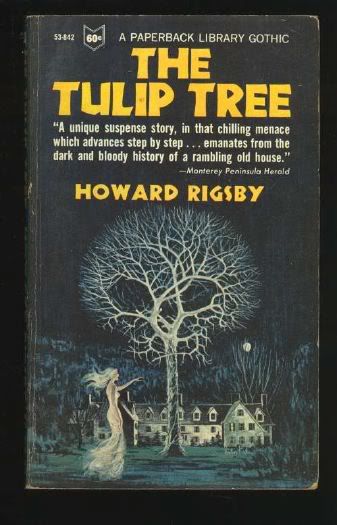
Unfortunately I couldn't find a cover scan for this novel, but it's simple enough to describe: Picture the "Easy Eye" logo at cover's top with "Large Type Non-Glare Paper" at its side. The art itself: Picture the Bates House in upper left-hand corner, beneath it a girl (Gillian) with shoulder-length straight brown hair in a red/white checked sleeveless dress who looks a lot like Hilary Swank aged 25. In cover's middle is marshland/ponds. The sky is gloomy/overcast. At cover's right side is a column of black smoke which looks like a tornado falling down. Gillian is looking at the column of smoke with trepidation.
This novel is a hoot. I've not finished it and am not sure I will, because it is so poorly edited and is flat-out zany. It starts out well enough; Gillian's on a train. She seems wise and level-headed. The train comes to an abrupt stop. Her friends, Sidney and Marylois, decide to exit the train and tramp to the nearby small town until the train's troubles are repaired (they have NO idea how long or short in duration this will be). Gillian of course thinks this is highly foolish of Sidney and Marylois; yet she decides to follow them! Gillian gets off the train, searches for her friends. They're nowhere in sight. Now she's confused. The train whistle blows and she runs for it; too late! That stupid Sidney and Marylois; how dumb could THEY have been?? :-p
Well Gillian's a heckuva lot dumber, because she suddenly finds herself in a quicksand-type bog which nearly kills her (who's the idiot now, again??). A strange man hears her cries for help however, and comes to rescue her. His name is Edward Webley.
Webley's a recluse. He has little money. Despite wishing to be left alone in this dreadful world of 1968 and being nearly flat-broke, he has an older married couple as hired hands. Makes no sense; little money, lots of time, claims to be a recluse and yet he's got "help."
Webley puts Gillian up for the night. But tomorrow she's GOT TO GO. He's never had guests before and dadblame it, she'll be the last. And he's not going to take her to her "new" (sight as yet unseen) house; the hired help will drive her there.
Next morning Webley's tearing down the road with Gillian as his passenger. Seems he's changed his mind awful sudden: Now HE will take her to the sight-unseen house she's bought.
They arrive at the house, which isn't a cottage but a villa; it's made of dark gray stones. Only the bedroom is furnished. Later we discover it's a cottage after all, and is pretty much furnished throughout. Another contradiction.
Gillian has no car of her own. She's nearly out of money (yet later offers to loan Webley money), no job, no foodstuffs in the house. Because of this, you guessed it: She'll be a guest in Webley's home again tonight (despite his adamant stance it'd be the one night only). They head for the car. Get in. Gilliam SLAMS the car door (she has a penchant for this). Webley's at the wheel, begins to drive off. Next thing we read, she's FOLLOWING him in the rain as he walks ahead of her; she watches the movements of his shoulders in the rainfall. They're sopping wet as they get into the car. *sigh*
She's going to spend the 2nd night at Webley's house, right? Nope, now Mr. Recluse (who hasn't seen the outlying towns in aeons) is taking her into town; to a bar, where people hate him. They're at the bar so Marylois can come pick Gillian up.
However, the novel does have a certain charm because of all its flaws. It also does have a solid enough storyline. I think the author was probably rather young, and didn't benefit from a good editor; a pity, because it had true promise imo. If I finish it, I'll do another review.






















































